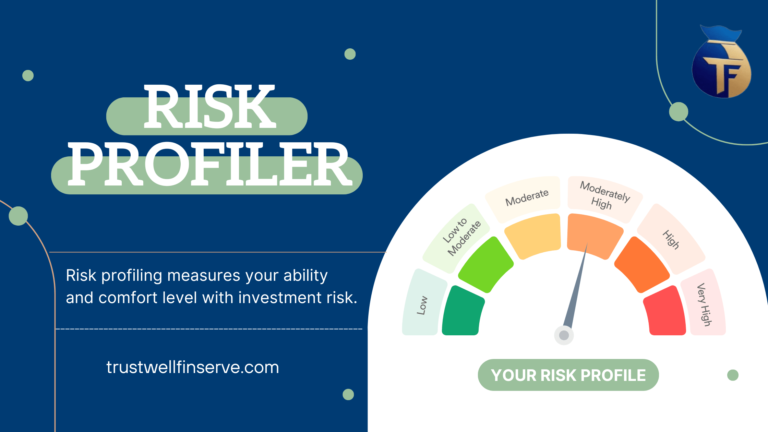Risk Profiler
How much risk are you comfortable taking? Discover your Risk Profile with this interactive tool, designed to evaluate both your willingness and capacity for Investment Risk. Gain insights into your ideal Asset Allocation between debt and equity, helping you make more informed financial decisions.
Your Risk Profile
Your Risk Profile
Disclaimer: This is a quick assessment of your risk profile. For a comprehensive evaluation, please consult a certified Financial Advisor. The descriptions provided are indicative and reflect typical investor behavior — use them as guidance or consider a reassessment if needed.
What Is Risk Profiling?
Risk profiling is the process of assessing an investor’s ability and willingness to take risks in financial decisions. It helps determine the ideal balance between safety and growth in an investment portfolio. Financial Planners use risk profiling to recommend assets that align with an individual’s comfort level and financial goals.
Why Is Risk Profiling Important for Investors?
Risk profiling is crucial because it ensures investors make informed and suitable investment choices based on their comfort level with risk. Without proper risk assessment, an investor might take on excessive risks they aren’t prepared for or miss growth opportunities by being overly cautious. A well-defined risk profile helps align investments with financial goals while maintaining emotional stability during market fluctuations.
What Is Risk Tolerance?
Risk Tolerance refers to how much risk an investor can endure emotionally and financially. It is influenced by factors like age, income stability, investment experience, and personality. Investors with high risk tolerance accept potential losses for higher returns, while low-risk investors prefer steady, predictable gains.
How Does Age Impact Risk Tolerance?
Age plays a significant role in determining risk tolerance. Younger investors often have a higher risk tolerance because they have time to recover from market downturns, allowing them to invest in high-growth and volatile assets. On the other hand, older investors approaching retirement tend to reduce their exposure to high-risk investments, favoring safer options like bonds and stable mutual funds.
What Is Risk Appetite?
Risk appetite is slightly different from risk tolerance—it’s the level of risk an investor is willing to take based on their financial objectives and confidence in the market. For example, someone may have a low risk appetite despite having the financial capability to take on higher risks.
What Are the Types of Risk Profiles?
Investors are typically categorized into six risk profiles, ranging from conservative to highly aggressive:
- Low Risk Profile – Prefers secure, low-volatility investments like government bonds or fixed deposits.
- Low to Moderate Risk Profile – Invests in balanced mutual funds or stable blue-chip stocks for steady growth with minimal risk.
- Moderate Risk Profile – Accepts market fluctuations, often investing in Diversified mutual funds and low-risk stocks.
- Moderately High Risk Profile – Seeks higher returns, willing to invest in growth stocks, sectoral funds, and emerging markets.
- High Risk Profile – Comfortable with significant volatility, investing in Equities, Small-Cap funds, and high-growth startups.
- Very High Risk Profile – Pursues maximum returns through speculative investments, cryptocurrencies, Derivatives, and high-growth industries.
What Role Does Psychology Play in Risk Profiling?
Psychological factors heavily influence risk profiling. Loss aversion, fear, optimism, and decision-making biases can shape how investors perceive risk. For instance, some investors panic during downturns and sell assets prematurely, while others remain confident and see market dips as opportunities to invest more. Understanding behavioral tendencies helps investors avoid emotional decision-making and stick to a rational investment strategy.
How Does Risk Profiling Affect Asset Allocation?
Asset allocation refers to how investments are divided among different asset classes like stocks, bonds, and alternative investments. Risk profiling directly impacts this allocation:
- Low-risk investors will have portfolios dominated by bonds and stable assets.
- Moderate-risk investors will balance equity and fixed-income instruments.
- High-risk investors will allocate more toward equities, emerging markets, and aggressive growth strategies.
A proper risk profile ensures diversification that matches financial goals while managing volatility.
Here’s a table outlining industry-standard asset allocation in India based on different risk profiles. This allocation is commonly used by financial advisors and Mutual Fund managers to balance risk and return.
| Risk Profile | Equity (%) | Debt (%) | Gold (%) | Real Estate (%) | Cash/Liquid (%) |
|---|---|---|---|---|---|
| Low (Conservative) | 10-20% | 60-70% | 5-10% | 5-10% | 10-15% |
| Low to Moderate | 30-40% | 40-50% | 5-10% | 5-10% | 5-10% |
| Moderate | 50-60% | 30-40% | 5-10% | 5-10% | 5-10% |
| Moderately High | 70-80% | 10-20% | 5-10% | 5-10% | 5% |
| High (Aggressive) | 80-90% | 5-10% | 5-10% | 5-10% | 5% |
| Very High (Speculative) | 90-100% | 0-5% | 5-10% | 5-10% | 5% |
Key Insights:
- Conservative investors prioritize debt instruments like fixed deposits, bonds, and debt mutual funds.
- Moderate investors maintain a balanced mix of equity and debt for steady growth.
- Aggressive investors focus heavily on equities, including small-cap and sectoral funds.
- Speculative investors may allocate almost entirely to equities, including high-risk assets like derivatives and cryptocurrencies.
This allocation varies based on market conditions, financial goals, and individual preferences.
Would you like to refine this further based on specific investment strategies or mutual fund categories?
📝 Click here to Schedule an Consultation
Can Risk Profiles Change Over Time?
Yes, risk profiles evolve based on life circumstances, financial conditions, and experience.
- Major life events (such as marriage, home purchase, or retirement) can shift risk tolerance significantly.
- Market experience can make investors more comfortable with volatility or push them toward safer investments.
- Economic conditions may affect investment confidence, prompting a reassessment of risk-taking behavior.
Regularly reviewing your risk profile ensures that your investment strategy remains aligned with your changing financial situation.
How to Assess Your Risk Profile for Investments?
To determine your risk profile, consider these steps:
- Evaluate Financial Stability – Assess your income, Savings, and expenses before committing to risky investments.
- Understand Your Time Horizon – Short-term investors might prefer lower risks, while long-term investors can tolerate higher market fluctuations.
- Take a Risk Assessment Questionnaire – Many investment platforms and advisors provide structured risk tolerance tests.
- Analyze Past Investment Behavior – Review how you reacted to market downturns in previous investments.
- Consider Your Financial Goals – If your goal is Wealth accumulation, higher risk may be acceptable. If security is a priority, a conservative approach is better.
How Do Financial Planners Do Risk Profiling?
Financial planners use a combination of psychological surveys, financial assessments, and market knowledge to determine an investor’s risk profile. They evaluate:
- Personal Income & Savings – Determines financial capability to handle losses.
- Investment Goals – Aligns portfolio choices with future needs (retirement, education, wealth building).
- Market Behavior Analysis – Understands an investor’s response to market volatility.
- Diversification Strategy – Suggests an optimal mix of high and low-risk assets for balanced growth.
Final Thoughts
Understanding where you stand on the risk spectrum is essential to crafting a portfolio that aligns with your financial ambitions. Whether you prefer stability or embrace volatility, a well-defined risk profile can help make informed investment decisions.



